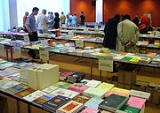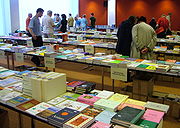
Esperanto literature
Encyclopedia
Esperanto literature began before the official publication of the constructed language
Esperanto
; the language's creator, L. L. Zamenhof
, translated poetry and prose into the language as he was developing it as a test of its completeness and expressiveness, and published several translations and a short original poem as an appendix to the first book on the language, Unua Libro
. Other early speakers wrote poetry, stories and essays in the language; Henri Vallienne was the first to write novels in Esperanto. Except for a handful of poems, most of the literature from Esperanto's first twenty years or so is now regarded as of historical interest only.
 Between the two World Wars, several new poets and novelists published their first works, including several recognized as the first to produce work of outstanding quality in the still-young language: Julio Baghy
Between the two World Wars, several new poets and novelists published their first works, including several recognized as the first to produce work of outstanding quality in the still-young language: Julio Baghy
, Eŭgeno Miĥalski, Kálmán Kalocsay
, Heinrich Luyken, and Jean Forge.
Modern authors include Claude Piron
and William Auld
, who was nominated for the Nobel Prize for Literature a number of times.
Esperanto has seen a solid production of material in Braille
since the work of the blind Russian Esperantist Vasilij Eroŝenko, who wrote and taught in Japan and China in the 1910s and 1920s.
Harold Brown wrote several modern plays in Esperanto.
Over 25,000 books in Esperanto
have been published, and the largest Esperanto book service at the World Esperanto Association
offers over 4,000 books in its catalog. Over 100 original novels have been published in Esperanto, plus a larger number of novellas, short story collections, and poetry collections. Two major literary magazines, Fonto and Literatura Foiro, appear regularly; some other magazines, such as Monato
, also publish fiction.
The most comprehensive guide to the literature of the language is Geoffrey Sutton's Concise Encyclopedia of the Original Literature of Esperanto (728 pages), published under the auspices of the Esperanto-speaking Writers' Association by MONDIAL, New York, N.Y., 2008, ISBN 978-1-59569-090-6.
Some of the major figures of Esperanto literature
:
Constructed language
A planned or constructed language—known colloquially as a conlang—is a language whose phonology, grammar, and/or vocabulary has been consciously devised by an individual or group, instead of having evolved naturally...
Esperanto
Esperanto
is the most widely spoken constructed international auxiliary language. Its name derives from Doktoro Esperanto , the pseudonym under which L. L. Zamenhof published the first book detailing Esperanto, the Unua Libro, in 1887...
; the language's creator, L. L. Zamenhof
L. L. Zamenhof
Ludwig Lazarus Zamenhof December 15, 1859 – April 14, 1917) was the inventor of Esperanto, the most successful constructed language designed for international communication.-Cultural background:...
, translated poetry and prose into the language as he was developing it as a test of its completeness and expressiveness, and published several translations and a short original poem as an appendix to the first book on the language, Unua Libro
Unua Libro
The Unua Libro was the first publication to describe the international language Esperanto . It was first published in Russian on July 26, 1887 in Warsaw, by Dr. L.L. Zamenhof, the creator of Esperanto. Over the next few years editions were published in Russian, Hebrew, Polish, French, German,...
. Other early speakers wrote poetry, stories and essays in the language; Henri Vallienne was the first to write novels in Esperanto. Except for a handful of poems, most of the literature from Esperanto's first twenty years or so is now regarded as of historical interest only.

Julio Baghy
Julio Baghy was a Hungarian actor and one of the leading authors of the Esperanto movement...
, Eŭgeno Miĥalski, Kálmán Kalocsay
Kálmán Kalocsay
Kálmán Kalocsay , in Hungarian name order Kalocsay Kálmán is one of the foremost figures in the history of Esperanto literature...
, Heinrich Luyken, and Jean Forge.
Modern authors include Claude Piron
Claude Piron
Claude Piron was a psychologist and a translator for the United Nations from 1956 to 1961....
and William Auld
William Auld
William Auld was a Scottish poet, author, translator and magazine editor who wrote chiefly in Esperanto. He was nominated for the Nobel Prize in Literature in 1999, 2004, and 2006 making him the first and only person to be nominated for works in Esperanto...
, who was nominated for the Nobel Prize for Literature a number of times.
Esperanto has seen a solid production of material in Braille
Braille
The Braille system is a method that is widely used by blind people to read and write, and was the first digital form of writing.Braille was devised in 1825 by Louis Braille, a blind Frenchman. Each Braille character, or cell, is made up of six dot positions, arranged in a rectangle containing two...
since the work of the blind Russian Esperantist Vasilij Eroŝenko, who wrote and taught in Japan and China in the 1910s and 1920s.
Harold Brown wrote several modern plays in Esperanto.
Over 25,000 books in Esperanto
Esperanto
is the most widely spoken constructed international auxiliary language. Its name derives from Doktoro Esperanto , the pseudonym under which L. L. Zamenhof published the first book detailing Esperanto, the Unua Libro, in 1887...
have been published, and the largest Esperanto book service at the World Esperanto Association
World Esperanto Association
The World Esperanto Association is the largest international organization of Esperanto speakers, with members in 121 countries and in official relations with the United Nations and UNESCO. In addition to individual members, 70 national Esperanto organizations are affiliated to UEA...
offers over 4,000 books in its catalog. Over 100 original novels have been published in Esperanto, plus a larger number of novellas, short story collections, and poetry collections. Two major literary magazines, Fonto and Literatura Foiro, appear regularly; some other magazines, such as Monato
Monato
Monato is a monthly magazine produced in Esperanto which carries articles on politics, culture and economics. It is printed in Belgium and distributed to readers in 65 countries. The title simply means "month"....
, also publish fiction.
The most comprehensive guide to the literature of the language is Geoffrey Sutton's Concise Encyclopedia of the Original Literature of Esperanto (728 pages), published under the auspices of the Esperanto-speaking Writers' Association by MONDIAL, New York, N.Y., 2008, ISBN 978-1-59569-090-6.
Some of the major figures of Esperanto literature
Literature
Literature is the art of written works, and is not bound to published sources...
:
- Marjorie BoultonMarjorie BoultonMarjorie Boulton is a British author and poet writing in both English and Esperanto.Author of Zamenhof: Creator of Esperanto — a biography of L. L...
- William AuldWilliam AuldWilliam Auld was a Scottish poet, author, translator and magazine editor who wrote chiefly in Esperanto. He was nominated for the Nobel Prize in Literature in 1999, 2004, and 2006 making him the first and only person to be nominated for works in Esperanto...
- Julio BaghyJulio BaghyJulio Baghy was a Hungarian actor and one of the leading authors of the Esperanto movement...
- Kazimierz BeinKazimierz BeinKazimierz Bein was a Polish ophthalmologist, the founder and sometime director of the Warsaw Ophthalmic Institute ....
(translations) - Jorge Camacho
- Vasili EroshenkoVasili EroshenkoVasili Yakovlevich Eroshenko was an anarchist writer, esperantist, linguist, and teacher. At the age of four, he contracted measles and as a result, became blind....
- Antoni GrabowskiAntoni GrabowskiAntoni Grabowski was a Polish chemical engineer, and an activist of the early Esperanto movement...
(mainly translations) - Kálmán KalocsayKálmán KalocsayKálmán Kalocsay , in Hungarian name order Kalocsay Kálmán is one of the foremost figures in the history of Esperanto literature...
- Nikolai Vladimirovich NekrasovNikolai Vladimirovich NekrasovNikolai Vladimirovich Nekrasov was a Russian Esperanto writer, translator, and critic.- Biography :Nekrasov was born in Moscow. A journalist, he worked in the publishing house Moscow worker...
- Mauro NerviMauro NerviMauro Nervi is an Italian poet in the Esperanto language.Nervi was born in La Spezia, a port town in northern Italy. A student of medicine, he gained his M.D. as a general surgeon. Since 1984 he has worked in the Department of Surgery at the University of Pisa...
- Claude PironClaude PironClaude Piron was a psychologist and a translator for the United Nations from 1956 to 1961....
- Frederic Pujulà i VallèsFrederic Pujulà i VallésFrederic Pujulà i Vallès was a Catalan journalist, dramatist, and a passionate Esperantist and contributor to the field of Esperanto literature. Born in Palamós, Catalonia, he travelled through Europe and stayed for a long time in Paris. He was involved in Joventut , the best "modernisme" review...
- Baldur RagnarssonBaldur RagnarssonBaldur Ragnarsson is an Icelandic poet and author of Esperanto works. He was a teacher and a superintendent of schools in Iceland.- Esperanto :...
- Raymond SchwartzRaymond SchwartzRaymond Schwartz , was a French banker and Esperanto author who wrote many poems and novels in Esperanto, as well as skits which he directed for Parisian Esperanto cabarets.-Biography:...
- Vladimir VarankinVladimir VarankinVladimir Valentinovich Varankin was a Russian writer of literature in Esperanto, an instructor of western European history, and director of the Moscow Ped. Instituto for foreign languages. He wrote the novel Metropoliteno.-Family background:Varankin was born in Nizhny Novgorod, in an office...
- Kitzo Hekotormos

